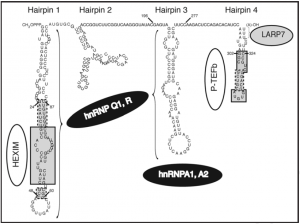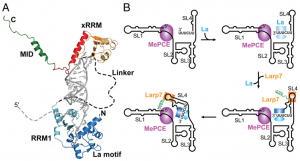LINC00339
Contents
Annotated Information
Name
Approved symbol: LINC00339
Approved name: long intergenic non-protein coding RNA 339
HGNC ID: HGNC:25011
Previous symbols: NCRNA00339
Previous names: non-protein coding RNA 339
Alias symbols: HSPC157
RefSeq ID: NR_109762
Ensembl ID: ENSG00000218510
LncBook ID: HSALNT0002923
Chromosome
1p36.12
Characteristics

~330 nt in vertebrates*. Transcribed by RNAP III, GC-rich sequence forming conserved secondary structures (especially 3' and 5' stem-loop motifs).
The 7SK gene is located on chromosome 6, and chromosome 6 is the sole human chromosome that produces 7SK RNA ((Driscoll 1994))
7SK RNA is capped at its 5' end by BCDIN3, a specific methylase methylphosphate capping enzyme (MePCE) ((Jeronimo 2007)).
RNAP II was recently found to bind near 7SK promoter, as well as many other known Pol III genes, suggesting that RNAP II may also play a role in regulating their transcription ((Raha 2010)).
In invertebrates, 7SK homologs may have different sizes (such as >400 nt and ~130 nt in drosophilids and nematodes, respectively). ((Gruber 2008)) ((Marz 2009))
Expression
Nuclear, highly abundant (one of the most abundant small RNAs in vertebrate cells), first isolated from HeLa nuclear extracts, but ubiquitously expressed.
RNA sequencing from 11 humans tissues confirmed ubiquitous high expression of 7SK with expression in some tissues being higher than any mRNA ((Castle 2010)).
Regulation
In the 7SK ribonucleoprotein, Larp7 binds directly to 3′ terminus of 7SK RNA ((Krueger 2008)) ((Markert 2008)), and prevents degradation of 7SK in vivo ((Krueger 2008)).
Function

7SK snRNA functions in transcriptional regulation by interacting with PTEF-B complex ((Nguyen 2001)) ((Yang 2001)), BAF chromatin-remodeling complex ((Flynn 2016)), or hnRNP R ((Briese 2018)). Consistently, it has been found highly enriched in isolated chromatin fractions, which may be related to its role in transcriptional regulation ((Mondal 2010)). In addition to its critical role for controlling transcription, 7SK snRNA is also involved in alternative splicing ((Barboric 2009)) and the localization of protein in nucleolus ((He 2007)). Therefore, 7SK snRNA has a variety of functions in the nuclear, playing important roles in cell growth and differentiation ((Nguyen 2001)) ((Yang 2001)), axon maintenance ((Briese 2018)) and vertebrate development ((Barboric 2009)).
7SK snRNA controls RNAP II activity by inhibiting P-TEFb elongation factor, which is a cdk-cyclin kinase that functions as both a general and an HIV-1 Tat-specific transcription factor ((Nguyen 2001)) ((Yang 2001)), with an impact on cell growth and differentiation. Specifically, 7SK snRNA functions as the central scaffold that coordinates protein-protein interactions and, by inhibiting P-TEFb kinase-mediated CTD phosphorylation, regulates RNAP II elongation ((Nguyen 2001)).
At an early stage of the HIV transcription cycle, elongation is prevented as P-TEFb is recruited to the HIV-1 promoter in a catalytically inactive state bound to the 7SK snRNP and also the Tat trans-activator of transcription protein. The inhibitory 7SK snRNP may be displaced by the nascent TAR HIV RNA that also binds Tat protein, activating P-TEFb kinase and transcriptional elongation ((D'Orso 2010)). Displacement of 7SK may also be performed by cellular RNAs, as indicated by the 3'-untranslated region (~300-nt) of HIC mRNA, which forms complexes with P-TEFb and is necessary and sufficient for stimulation of P-TEFb-dependent transcription of the HIV promoter ((Young 2007)).
7SK snRNA inhibits enhancer transcription by modulating nucleosome position. 7SK physically interacts with the BAF chromatin-remodeling complex, recruits BAF to enhancers and inhibits enhancer transcription by modulating chromatin structure ((Flynn 2016)).
In axons, 7SK snRNA interacts with hnRNP R to regulate its function in axon maintenance ((Briese 2018)).
7SK snRNP (composed of 7SK snRNA, Hexim1, Larp7/Pip7S, and the P-TEFb subunits CycT1 and Cdk9) is not only critical for controlling transcription, but also for regulating alternative splicing coupled to transcription elongation ((Barboric 2009)). 7SK snRNP disintegration promotes inclusion of an alternative exon via the increased occupancy of P-TEFb, Ser2-phosphorylated (Ser2-P) RNAPII, and the splicing factor SF2/ASF at the minigene ((Barboric 2009)).
7SK snRNA also inhibits APOBEC3C deaminase activity and sequesters it to the nucleolus, suggesting broader role for 7SK RNA in regulating key nuclear functions ((He 2007)).
Disease
colon adenocarcinoma [1]
Evolution
Please input evolution information here.
Labs working on this lncRNA
Please input related labs here.
References
- ↑ Shahriyari L. Effect of normalization methods on the performance of supervised learning algorithms applied to HTSeq-FPKM-UQ data sets: 7SK RNA expression as a predictor of survival in patients with colon adenocarcinoma. Brief Bioinform. 2017 Nov 3. doi: 10.1093/bib/bbx153.
Sequence
>gi|564473412|ref|NR_109761.1| Homo sapiens long intergenic non-protein coding RNA 339 (LINC00339), transcript variant 4, long non-coding RNA
000081 TCTTATCCTG ATCTTTCCTC GTCCCCCGCT CCCCCGTCCT CCGAGGTGGC AGCTGCATCG GGGGTCATAC TACACATCGA 000160
000161 TCGGGACCTT AGTCATGTTG TGATATGGAC AGCTTTCTTA CCAGTACTCA TAAGCCTGCT TCATTTTTTA CGTGGCGGCA 000240
000241 CCACTGAGTG GTTGACGAAG TCTGGAACGT TTTTTCTTAG AGTTCCAGAA TTGAGACTGA AGTGTACCCA GAGACACAAA 000320
000321 GAAATACAGA AGTCCAGAAT GATCAAATGA GATCACTACC CAATGAAATG ATGGGCCGAG GAGCCAGAAG TTGTCCTACT 000400
000401 ACCTGCTTTC CAGGTCCAGA TTCCACGAGA GCCTTCTGGG CTCCCACCAG AGACCCTCAG TGAAGACTCT GTTGAAGACT 000480
000481 TTAAGACCAT GCTAGAAAGC CTCCCGGCAG AGGTTCAGGA AGTTCTGCTA TGAGGATGCA GCTGGCCCCA GGGATGTCCT 000560
000561 CAGGCATCTC TAGGACCTTG CTGGACGGTG GTGGCTGAGA CCTGATATCC ACACAAAGGA GCAGACTGTG GAAATGCTGG 000640
000641 TGCAGGAGCA ATTCCAGGCT GTCCTGCCCG AGGAGCTCAG AGCTCAAGCA CAGAGATGTC AGCCTGGAAT CAGAATCACT 000720
000721 GGCTAAGTCT TGCTGCTTGC TTCTTGCTCA GCCTGCATAT GAGAAGTCAA CCAAGCATTC TCTTGGATGC AAGATCCAAC 000800
000801 TGCACCCATG GGAAATCTGA ACTTCCACTT TCTTTGAGCT TGTCTTTGGT TGTAATAAGA ATCCATCAAA ACCCATGTCT 000880
000881 GGATCTCTCT TTGGCTGAGG CAGCTTTATT TCCTACAGAA AGAGTTTCTC TGTCCTCTTG TTAGGACAAT CAGCCTGCTG 000960
000961 CTTTGGGCTT TTCCAAGAGC CTATTTTTCA TCTGCTGGAT GCCTCTTTTT TTTTTTTTTT TTTTTTTTGC ACTGTGTGAC 001040
001041 ATGCTTTAAT ATATATATTT TTTATGTATC CAAAGAGGTA ATCAACTTTA ACTTTCAGAA TTCATGAATC TTGGTTTGGT 001120
001121 GGCATGAATG AAAGGTTATG TAACCCCACC AGTAACTCAT TTGGGGTGCC CTTGAAATAT TAAAGTTTGG TCCTCAATAA 001200
001201 AT